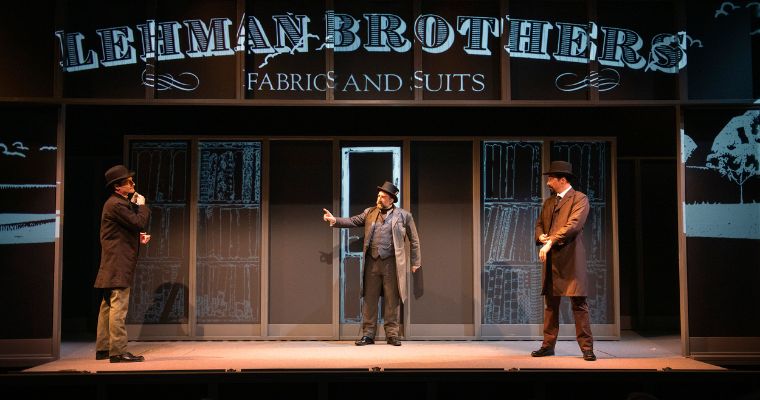
From left, Mark H. Dold, James Zannelli, and Brandon Morris are the Lehman Brothers in GableStage's "The Lehman Trilogy." (Photos by Magnus Stark)
“The Lehman Trilogy,” an epic and timely play about a globally significant family and company, covers roughly 160 years and lasts for about three hours (not including two 15-minute intermissions). But do not, even for an instant, fret about the running time.
Truly, this sprawling story unfolds like a compelling human interest feature that you just can’t put down. In fact, at the end (which comes faster than you expect), you may find yourself wanting to stay with the characters longer. That is because they are relatable, humorous, playful, imperfect and, like many of us and our ancestors, they were immigrants who bravely sought the American Dream.
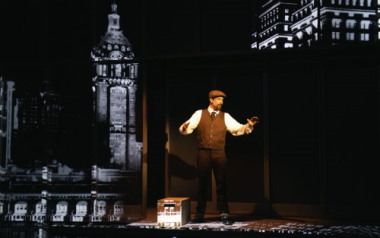
Brandon Morris plays middle brother Emanuel. (Photos by Magnus Stark)
“The Lehman Trilogy,” about the rise and fall of the renowned Lehman Brothers, Inc. financial services firm, is onstage through Sunday, April 21 in a riveting GableStage production. Italian playwright Stefano Massini conceived the work as a five-hour radio play. Then, Ben Power adapted it in English into a three-hour piece (again, not including the intermissions).
After experiencing the play, you may think that the three impressive actors who comprise most of the cast belong in a circus. Indeed, they deftly juggle portraying between 50 and 75 characters. In addition, they narrate the action like expert storytellers.
The three main actors are Mark H. Dold, Brandon Morris, and James Zannelli. A fourth actor, Sean Deam, appears briefly as a janitor.
Dold, Morris, and Zannelli, under GableStage Producing Artistic Director Bari Newport’s careful direction (the associate director is Jeni Hacker), portray everyone from children to rabbis to plantation owners, politicians and various businessmen. Of course, the performers mainly portray the Lehman siblings, three devoutly Jewish brothers who emigrate from Germany to the U.S. during the 1800s in search of a better life.
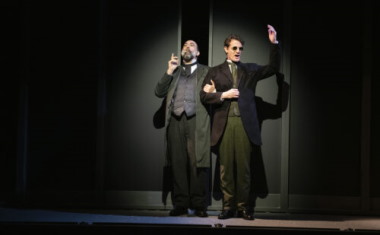
The three actors play more than 50 roles: At left, James Zannelli as the divorcee and Mark H. Dold as Bobby Lehman. (Photo by Magnus Stark)
Indeed, you can grow dizzy and tired just thinking about the many characters these performers portray over three hours. But Dold, Morris, and Zannelli seem to possess the essential stamina to succeed. In addition, they seamlessly slip in and out of each character, and display impressive naturalism. For instance, with a change of posture, facial expression, or tone of voice, they switch from one character to another. Also, to the performers’ and their director’s credit, the actors emphasize important words.
There are no costume changes, the scenery is minimal, and the performers unnoticeably pluck props from their pockets or from behind one of the stage’s panels.
Power, based on Massini’s original play, neatly organizes the adaptation into three parts. Also, the author writes vividly and wisely uses symbolism. For example, a heavy, seemingly unending rainstorm symbolizes a dark time economically. At other times, a tall stack of items stands but is in danger of falling. This might symbolize how the family’s business came crashing down. And the inclusion of a tightrope walker on Wall Street can symbolize the bravery of the brothers to come to a strange, new land, leaving behind everything they’ve ever known.
While the piece centers on a family that eventually operated a financial business, the playwright refrains from making “The Lehman Trilogy” a dry economics lesson with unfamiliar, unexplained terms. Also, the play never comes across as a history lesson. Rather, it is filled with humanity, and covers relevant themes such as ambition, family, finances, dreams, immigration, religion, as well as personal and public success and failure. What emerges is more than a vivid snapshot of a hard-working and deeply religious family pursuing their share of the American Dream.
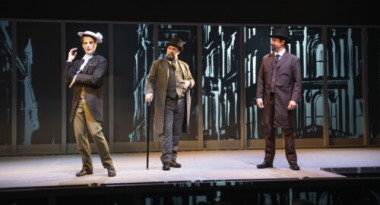
James Zannelli (center) and Brandon Morris (right) watch as Mark H. Dold plays hard-to-get Pauline. Photos taken by Magnus Stark
While “The Lehman Trilogy” succeeds in several ways, the play is flawed. For instance, the piece focuses on Jewish traditions without explaining them and not translating Hebrew phrases such as “Baruch Hashem.” The phrase, used mainly by Orthodox Jews to express thanks to God, literally means “Blessed Be God.” In fact, it wouldn’t have hurt for the production’s program to include such terms and their translations or explanations. On the plus side, the program includes a detailed Lehman family tree and lengthy timeline.
As solid as the play is, the author leaves us wondering what happened that made Lehman Brothers, Inc. declare bankruptcy.
On Sept. 15, 2008, the company filed for Chapter 11 bankruptcy protection following the exodus of most of its clients, drastic declines in its stock price, and the devaluation of assets by credit rating agencies. The collapse was mainly due to Lehman’s involvement in the subprime mortgage crisis and its exposure to less liquid assets. Lehman’s bankruptcy filing was the largest in U.S. history and economists believe it played a major role in the financial crisis of 2007-2008.
Actually, the play begins around that time. Specifically, we are in a Manhattan high-rise office building where a literal mess could symbolize the company’s collapse. Boxes are strewn about and chairs rest upside down. That’s when we see a janitor (Deam) vacuuming and picking things up.
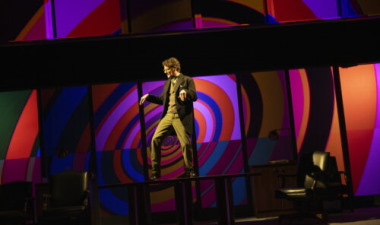
Mark H. Dold dances on a boardroom table as Bobby Lehman. (Photos by Magnus Stark)
After the janitor leaves, the play flashes back to the 1800s, and a bald-headed man with a salt and pepper gray beard appears from the audience seating area. He is holding a suitcase and stands in a spotlight (the lighting designer is Tony Galaska). We learn that the man is one of three brothers “who came to America with nothing, without a word of English and they built an entire universe.”
The man is Henry Lehman (Zannelli), the eldest sibling. He stands close to us while narrating his and his siblings’ story. We feel a personal connection to him because he stands near us rather than onstage (the stage is one level higher than the audience sits). Soon after the play begins, Henry has just arrived by boat from Rimpar, Bavaria, Germany.
Meanwhile, Morris plays Emanuel Lehman. He arrives in America three years after Henry, joining his brother in the dry-good business in Montgomery, Alabama. The younger brother, Mayer (Dold) arrives a month later.
While the actors shine, so do the artists who work behind the scenes. The main set is an office building in New York City. Scenic designer Frank J. Oliva designed it simply, yet with enough detail to place us in such a setting. In addition, paneled flats create palettes for projections. The projection designer is Jamie Godwin. Her vivid hand-drawn projections set the scene.
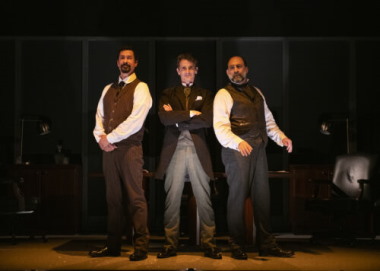
The Lehman Brothers, from left, Brandon Morris as Emanuel, Mark H. Dold as Mayer, and James Zannelli as Henry. (Photos by Magnus Stark)
As far as the set panels, they combine to create various configurations, spaces, streets, homes, and boardrooms. Four crew members make all of the choreographed moves of the set happen. In the lighting department, designer Galaska deftly creates the moods for different eras from the mid-1800s to the 2000s. Galaska also knows when to increase the lighting’s intensity and when to go dimmer.
Also, behind the scenes, Camilla Haith’s period costumes help bring the characters to life and set the scene.
“The number of people who have contributed to this production are too many to list,” Newport wrote in the program.
Indeed, everyone from rabbis to bankruptcy attorneys had a hand in creating it.
Quality live theater relies on collaboration. And it appears as though GableStage’s team collaborated well to present us with a highly complex work of astounding art that everyone should experience.
Kudos to GableStage for bringing “The Lehman Trilogy” to South Florida. In fact, this production is only the fifth to be done in the U.S. It further cements the nonprofit, professional theater company as a bold group unafraid to tackle complex, thought-provoking work.
GableStage’s production of "The Lehman Trilogy" runs through Sunday, April 21 at GableStage Theatre Company in the Biltmore Hotel, 1200 Anastasia Ave. in Coral Gables. Showtimes are 2 p.m. Wednesday, 7:30 p.m. Thursday-Saturday, 2 p.m. Sunday (additional 7:30 p.m. performances Tuesdays begin in April), through April 21. Tickets are $45, $50, $55, $60, $65, all with an additional $10 service fee (discounts are available for students, teachers, artists, military, and groups). For more information, call (305) 445-1119 or go to www.gablestage.org.
Related event: Dr. Josh Parshall, director of history at the Goldring/Woldenberg Institute of Southern Jewish Life will speak about “The Jewish Diaspora in the American South: Southern Jews and the Cotton Economy” at 7:30 p.m. Tuesday, March 26 at The Hub at Temple Beth Am, 5950 N. Kendall Dr., Pinecrest. Admission is free, but reservation required. To RSVP, go to ci.ovationtix.com.
 MAIN MENU
MAIN MENU

